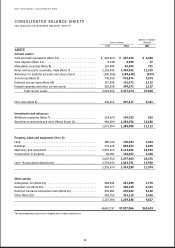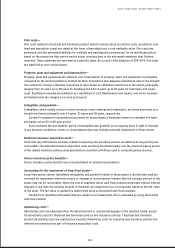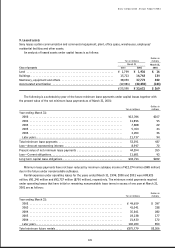Sony 2001 Annual Report Download - page 101
Download and view the complete annual report
Please find page 101 of the 2001 Sony annual report below. You can navigate through the pages in the report by either clicking on the pages listed below, or by using the keyword search tool below to find specific information within the annual report.
Sony Corporation Annual Report 2001
99
Sony has adopted SOP 00-2 retroactively to April 1, 2000. As a result, Sony’s operating income, income
before income taxes, and net income for the year ended March 31, 2001 each decreased by ¥28,547 million
($228 million). Additionally, Sony’s net income for the year ended March 31, 2001 included a one-time, non-cash
charge with no tax effect of ¥101,653 million ($813 million), primarily to reduce the carrying value of its film
inventory. The charge has been reflected as a cumulative effect of an accounting change in the accompanying
consolidated statements of income.
Pursuant to SOP 00-2, pro forma financial information for prior years is not required.
Revenue recognition—
During the year ended March 31, 2001, Sony adopted Staff Accounting Bulletin (“SAB”) No. 101, “Revenue
Recognition in Financial Statements” issued by the United States of America Securities and Exchange Commis-
sion retroactively to April 1, 2000. As a result, Sony has changed its method of accounting for revenues from
electronics, game and music sales. Revenues from electronics, game and music sales are recognized upon deliv-
ery which is considered to have occurred when the customer has taken title to the product and the risk and
rewards of ownership have been substantively transferred. Following SAB No. 101, revenues are recognized
when the product is delivered to the customer delivery site. Previously Sony followed the guidance of FASB
Statement of Financial Accounting Concept (“SFAC”) No. 5 “Recognition and Measurement in Financial
Statements of Business Enterprises” in which revenues were recognized when Sony had substantially com-
pleted all of its obligations pursuant to the terms of the sales contract. Under the guidance of SFAC No. 5, Sony
viewed its obligation under the sales contract to be substantially completed when products were shipped and
recognized revenues at that time. In accordance with SAB No. 101, Sony has recorded a one-time non-cash
charge of ¥2,821 million ($23 million), including ¥491 million ($4 million) income tax expense, which represents
the net impact of sales that were previously recognized in the year ended March 31, 2000. These sales were
subsequently recognized in the year ended March 31, 2001 due to the adoption of SAB No. 101. The charge has
been reflected as a cumulative effect of an accounting change in the accompanying consolidated statements of
income. The accounting change did not have a material effect on Sony’s consolidated statements of income for
the year ended March 31, 2001. Sony has not disclosed pro forma financial information for prior years as if SAB
No. 101 had been applied retroactively due to immateriality.
(2) Significant accounting policies:
Basis of consolidation and accounting for investments in affiliated companies—
The consolidated financial statements include the accounts of Sony Corporation and those of its majority-owned
subsidiary companies. All intercompany transactions and accounts are eliminated. Investments in which Sony
has significant influence or ownership of more than 20% but less than or equal to 50% are accounted for under
the equity method. Under the equity method, investments are stated at cost plus/minus Sony’s equity in undis-
tributed earnings or losses. Consolidated net income includes Sony’s equity in current earnings or losses of such
companies, after elimination of unrealized intercompany profits. If the value of an investment has declined and
is judged to be other than temporary, the investment is written down to its fair value.
On occasion, a subsidiary or affiliated company accounted for by the equity method may issue its shares to
third parties as either a public offering or upon conversion of convertible debt to common stock at amounts per
share in excess of or less than Sony’s average per share carrying value. With respect to such transactions, the
resulting gains or losses arising from the change in interest are recorded in income for the year the change in
interest transaction occurs.
The excess of the cost over the underlying net equity of investments in subsidiaries and affiliated companies
accounted for on an equity basis is allocated to identifiable assets and liabilities based on fair values at the date
of acquisition. The unassigned residual value of the excess of the cost over the underlying net equity is recog-
nized as goodwill.
























